5.23 Maytas LLWR Release Notes
Note regarding submissions
We would like to remind providers to create a submission early and check for any errors using reports from the appropriate software (i.e. the FIS or LLWR-Inform). Welsh providers should also remember to download their ULI file. After submission to the ESFA or DfES, providers should check that data has submitted correctly using the available reports. Providers should check that all their expected starts and completions are submitted correctly, and that start and outcome payments correctly match the PFR or ACE funding reports.
Our support desk gets extremely busy in the days prior to the submission deadlines, and although we try and prioritise submission-related queries, we cannot guarantee assistance if queries are sent late. If you do encounter any issues, please ensure that you contact Maytas Support as soon as possible, as we can only rectify issues of which we are aware. We also recommend checking Maytas Communities regularly for information on any known issues and solutions. Tribal cannot be held responsible for any issues caused by your failure to comply with this advice
Technical specification
The latest Maytas and Maytas Hub technical specification can be found here.
Once the upgrade has been completed, the version number should be checked to ensure it has been successful.
- Start Maytas and go to Support on the toolbar.
- Click About.
- The version numbers should read 5.23.8000.3. If you have any other version, please ensure you have followed the upgrade instructions correctly. If you require assistance, please contact Maytas Support.
It is the responsibility of customers to ensure that users carry out any required user acceptance testing and sign off on the upgrade.
Complete the Upgrade
Features Added in the Upgrade
These are the main updates in the upgrade:
- LLWR tab, report and export updates for Job Growth Wales+ (JGW+)
- Permissions search
- Fixes to a number of issues
Reports Library 1.0.4.1 is also included in the upgrade but must be installed separately, which is detailed in the Upgrade Guide. The reports library can be downloaded here. If you are a hosted customer, please contact the Service Desk to arrange for the reports library update to be applied.
Maytas 5 Version 5.23.8000.3 Release Notes
Maytas Support and Self Service
Maytas Support will soon be changing so that the available ways of contacting our support team are by telephone and by the Self Service portal, which allows you to raise tickets and track existing requests. Emailing the service desk directly will not be supported as a method for raising Maytas Incidents or Service requests from March 2022.
Incidents and Service Requests can be raised on the Self Service portal, which can accessed at:
The central Service Desk can be called on +44 1143080080. This is only recommended for P1 incidents or if you are unable to access the Self Service portal.
A guide to these changes can be found here.
Generic LLWR Scheme
Due to the large number of similar / redundant Welsh schemes which need to be maintained each year, a new generic scheme called LLWR Scheme [Wales] has been created which we encourage providers to use for all future LLWR learners.
We are aware that some providers use scheme as a means of identifying the type of learning that learners are undergoing. It is recommended that LP17 Type of Learning Programme (TRAINEEPOT2.LLWR_PROGTYPE) should be used for this purpose instead.
Jobs Growth Wales+ (JGW+) Updates
The LLWR tabs, report and export for 2021/22 have been updated to include the new requirements for the JGW+ programme.
In terms of data collection, a new Wage Subsidy Data section has been added to the LLWR Programme 2021 tab.

Click the  button to add a new row.
button to add a new row.
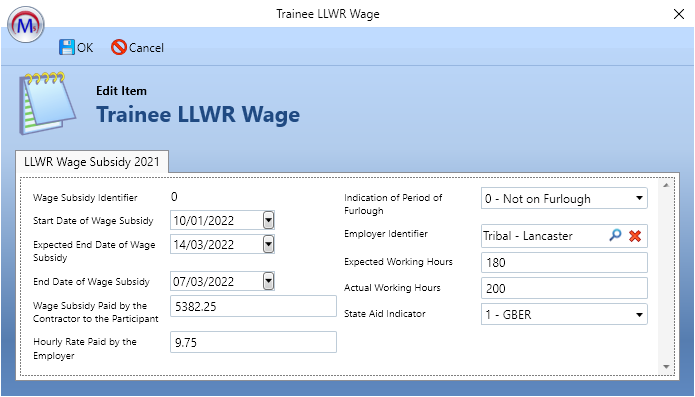
Complete the data as required and click OK.
Additionally, the following new fields have been added to the LLWR 2021 tabs:
| Field Name | Database Table and Field | Location |
|---|---|---|
| LN23 Email Address | TRAINEE.EMAIL | LLWR Programme 2021 (Learner Data) |
| LA49 JGW Activity Descriptors | TRAINEE_LLWR_ACT.JGW_AD | LLWR Activity 2021 |
| LA50 Employer Identifier | TRAINEE_LLWR_ACT.EMPLOYERID | LLWR Activity 2021 |
Contracts Setup
New schemes are available for JGW+ which must be added to the relevant Welsh contracts for them to be included in the LLWR export. This can be done either by creating a new formula-funded contract or by adding contract lines linked to the new schemes to an existing contract.
The new schemes are:
- JGE - Jobs Growth Wales + Engagement
- JGA - Jobs Growth Wales + Advancement
- JGM - Jobs Growth Wales + Employment
- LLWR - LLWR Scheme [Wales]
While the JGW+ schemes can be added and used for existing reporting needs, we encourage providers to instead use the LLWR Scheme [Wales] option going forwards (see above for details).
To create a new contract:
- Go to Management on the toolbar and click Contracts.
- Left-click the contractor (company) to which you wish to add the new contract.
- Click Add Contract on the ribbon.
- Make sure that option 1. Existing company is selected then click Next.
- Enter a contract description (e.g. DfES 2021/22 v2).
- Enter a contract number if required.
- Select the DfES Contract (Wales) option.
- Select year 2021/2022.
- Click Next.
- Select the schemes you wish to include in the contract and click Next.
- Click Finish.
To add contract lines to an existing contract:
- Go to Management on the toolbar and click Contracts.
-
Click the arrow to the left of the relevant contractor to expand its tree view, then expand the contract you wish to edit and select Contract lines.
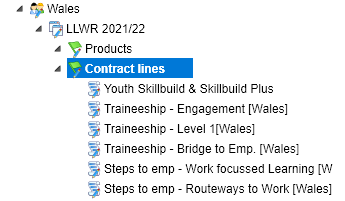
- On the right side of the screen, click the
 button to add a new contract line.
button to add a new contract line. -
Enter a description for the contract line and select the required scheme.
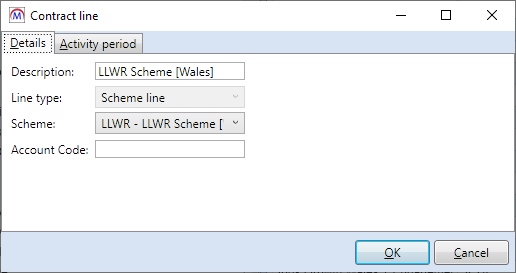
- Click OK.
- Repeat for additional schemes as required.
Note on Employer Identifiers
New Employer Identifier fields are included on both the Activity and Wage Subsidy datasets. As per the LLWR specification and clarification from the Welsh Government, these Employer Identifiers do not necessarily have to be for an employer record included in a learner's Employment Period dataset, and so theoretically any previously or newly submitted employer record could be used for the Activity and Wage Subsidy Employer Identifiers.
While we expect this will only apply in rare circumstances, this has been implemented in Maytas so that any employer record can be selected for these fields. However, it is important that you ensure any employer records selected in these fields have been included for at least one learner in a submitted LLWR export so that the Welsh Government have the relevant employer record on file. This means that any employer used for the Activity and Wage Subsidy Employer Identifiers MUST have the Include in LLWR Exports box ticked on the LLWR Employment Period Data tab. This can be found by going to the LLWR Programme tab for a learner who is associated with the employer, opening the employer record in the Employer Data section and then going to the LLWR Employment Period Data tab.
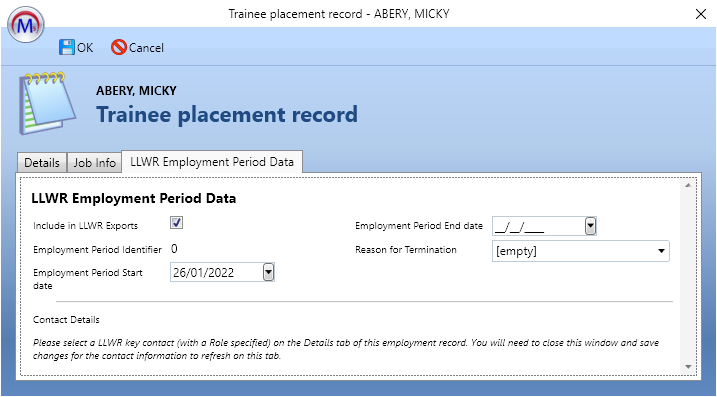
If an employer is selected for an Employer Identifier and it has NOT been submitted in an export, the identifier will still be exported but an error will appear in the export's View Log option. This will likely also result in errors upon submission.
Force Email Export for Non-JGW+ Learners
By default, the LN23 Email Address field is only exported for JGW+ learners (determined by LP17 Type of Learning Programme). It is possible to force LN23 to be exported for a learner by adding the field TRAINEEPOT2.LLWR_FORCE_EMAIL to a learner tab in the Screen Designer. This will add a checkbox which can then be ticked for a learner to force LN23 to export for them.
Scheduler
The Scheduler is a centralised tool for setting up and viewing all things that can be scheduled in Maytas. This includes the features from the Report Scheduler introduced in the 5.21 upgrade, but also allows you to manage schedules for the funding cache.
To enable the Scheduler for a user:
- Go to Tools | Edit Permissions.
- Select the user or group which requires permission.
- Go to the Commands tab and expand the Scheduler section.
- Set the permission Show Scheduler to Visible.
- Click Apply.
- Restart Maytas for the permission to take effect.
To access the Scheduler, go to Tools | Scheduler.
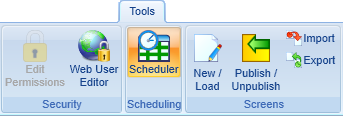
The Scheduler will open.
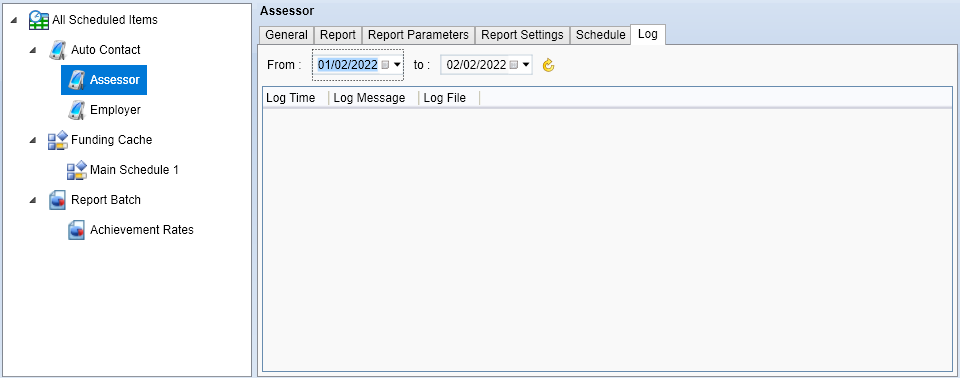
The tree view on the left lists all scheduled items, split by auto-contact reports, funding cache schedules and report batches.
Create a Funding Cache Schedule
- Go to Actions on the toolbar and select New | Funding Cache.
- On the General tab, enter a name and description for the schedule.
-
Choose the years to run the funding cache for. If you wish to include a refresh of the QAR cache as well, tick the Ofsted Data box.
For FM36 funding, funding cache information from previous years is used in the calculations. However, if data has not changed for a previous year since the last funding cache update, that year does not need to be included in the cache update each time as it will remain unchanged. As such (and taking into account that the more years that are included, the longer the cache update will take), it is recommended to only include previously cached years when data is likely to change for them (e.g. the previous year) or if you know of specific data that has changed for a past year.
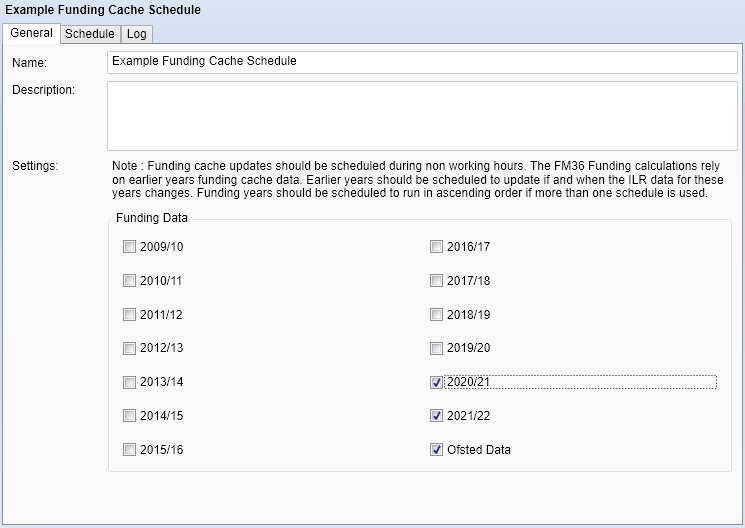
-
Go to the Schedule tab. This is where you can configure when (and how often) the funding cache will run.
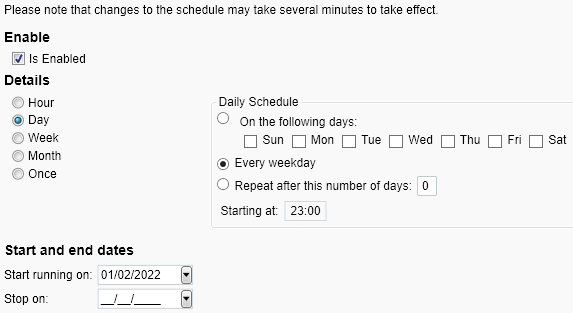
-
Set the schedule in the Details section. It can be set to run periodically (e.g. every day, week, etc) or just once at a specified time. Please note that if you intend to start the schedule immediately, the start time should be at least 10 minutes in the future to ensure it is picked up by the system.
It is strongly recommended to schedule the funding cache to run out of business hours, as it can take a long time to complete depending on the size of the database and various other factors and may use a large amount of system resources during that time.
- Set the start date at the bottom of the window. The schedule will run indefinitely by default, but if you want the schedule to end on a particular date then tick the Stop this schedule on box and set the date.
- When you have finished configuring the schedule and want to activate the schedule, tick the Is Enabled box at the top of the tab.
- Click Apply on the ribbon to save the schedule.
The Log tab shows a log of when the schedule has been run, which can be filtered between two dates.
Create an Auto Contact Schedule
Auto Contact schedules require a mail merge report to be configured for auto-communication. Details of this can be found here.
- Go to Actions on the toolbar and select New | Auto Contact.
- On the General tab, enter a name for the schedule. Leave the subject and message for now.
- Go to the Report tab and select Maytas on the left.
-
Select the report you wish to use on the right. Note that only reports configured for auto-communication will appear here.
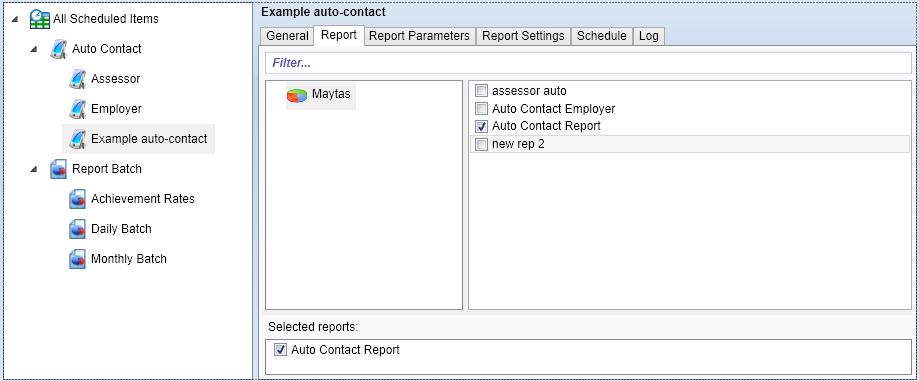
- Go back to the General tab and amend the subject and message as required (they will default to the values entered when configuring auto-communication).
-
Go to the Report Parameters tab and click the arrow next to the chosen report to expand its parameters.
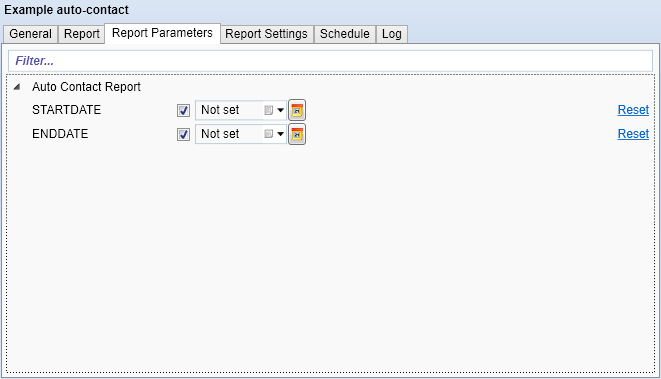
In this example, the report filters learners based on their POT start date being between the STARTDATE and ENDDATE parameters.
- Configure the parameters as required.
-
Go to the Schedule tab.
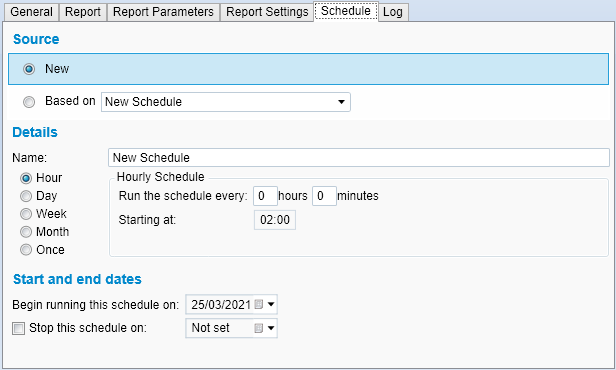
- On this screen, the schedule can be configured. If you have an existing schedule, you can choose it by clicking Based on and selecting it from the list. Otherwise select New.
- Set the schedule in the Details section. It can be set to run periodically (e.g. every hour, day, month, etc) or just once at a specified time. Please note that if you intend to start the schedule immediately, the start time should be at least 10 minutes in the future to ensure it is picked up by the system.
- Set the start date at the bottom of the window. The schedule will run indefinitely by default, but if you want the schedule to end on a particular date then tick the Stop this schedule on box and set the date.
- Click Apply on the ribbon to save the schedule.
The Log tab shows a log of when the schedule has been run, which can be filtered between two dates.
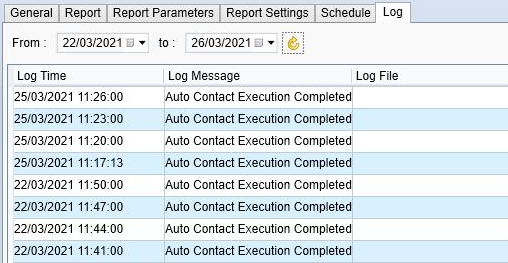
The Report Settings tab shows key information about how the report auto-communication is configured. Note that this tab is read-only.
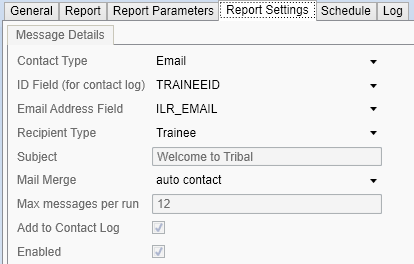
Create a Report Batch Schedule
- Go to Actions on the toolbar and select New | Report Batch.
-
On the General tab, enter a name for the batch and enter your recipient email addresses in the email recipients box at the bottom.
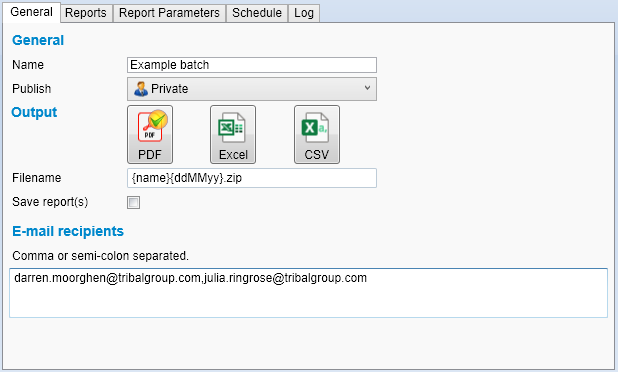
There are also options to publish privately, globally or to a group, to export to PDF, CSV or Excel and to alter the filename, but for this example we will accept the defaults. Note that the default filename of {name}{ddMMyy}.zip will create a file using the batch name and the date it was created.
-
Go to the Reports tab, where you can choose which reports to include in the batch. Click the arrow next to Maytas or Reporting Services to shows reports created in Report Generator or reports from the Reports Library respectively. The select reports will be shown at the bottom of the screen.
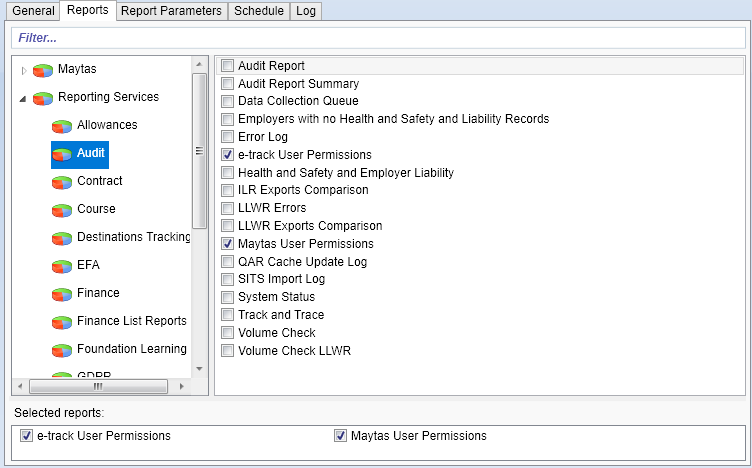
-
Go to the Report Parameters screen and click the arrow next to each report to expand its parameters. Configure the parameters as required.
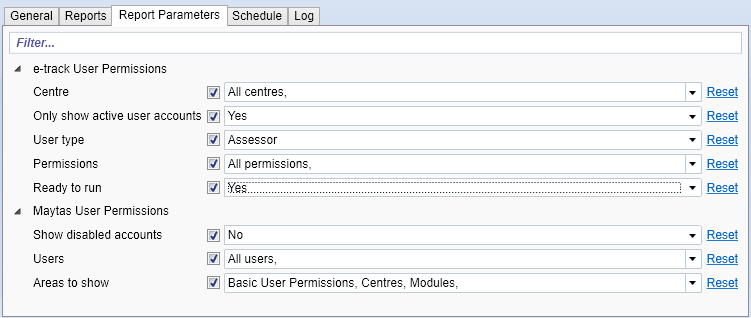
-
Go to the Schedule tab.
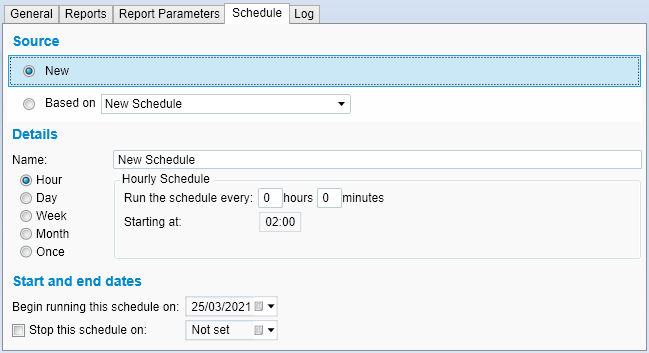
- On this screen, the schedule can be configured. If you have an existing schedule, you can choose it by clicking Based on and selecting it from the list. Otherwise select New.
- Set the schedule in the Details section. It can be set to run periodically (e.g. every hour, day, month, etc) or just once at a specified time. Please note that if you intend to start the schedule immediately, the start time should be at least 10 minutes in the future to ensure it is picked up by the system.
- Set the start date at the bottom of the window. The schedule will run indefinitely by default, but if you want the schedule to end on a particular date then tick the Stop this schedule on box and set the date.
- Click Apply on the ribbon to save the schedule.
The Log tab shows a log of when the schedule has been run, which can be filtered between two dates.
Report Scheduling Configuration Options
There are several configuration options which can be set for report scheduling:
- Click the M5 button at the top-left and select Options.
- Select Admin on the left (under the Maytas 5 header).
-
Scroll down to the Reporting section on the right. There are three applicable options:
- Scheduling Verbose Logging - Off by default. When this is enabled, the logs for report batches will include additional information. After enabling it, Maytas must be closed and the data service must be stopped and restarted in Maytas Server Manager (please contact Tribal if your Maytas server is managed by us).
- Include email messages in scheduling logs - Enabled by default. This will include the contents of email messages in the log entries.
- Remove mail attachments from scheduling log entries - Enabled by default. This will remove mail attachments when saving email content in log entries.
- An additional option, Scheduling Verbose Logging, can be found by selecting Auto Contact on the left (under the Maytas 5 header). This is off by default. When it is enabled, the logs for auto-contact schedules will include additional information. After enabling it, Maytas must be closed and the data service must be stopped and restarted in Maytas Server Manager (please contact Tribal if your Maytas server is managed by us).
- Click OK when finished.
Edit Permissions - Search for Permissions
The Edit Permissions screen now includes a search box to let you search for permissions on each tab.

Employer on Skill Scan Queue Tab
The Skill Scan Queue tab for learners now displays the relevant employer for each scan.

To import the updated tab:
- Go to Tools on the toolbar.
- On the Screens panel of the ribbon, click Import.
- Click Browse.
- Browse to the Maytas 5\Extras\Tabs folder of the upgrade, select Skill Scan Queue.m5tab and click Open.
- Click Next to import the tab.
- Click Finish.
- Go to Home on the toolbar and click the Sync button.
Reports Library 1.0.4.1
Assessor and Employment Type Overhaul
The reports library has been overhauled so that all reports that use a learner's assessor type or employment type now allow you to select the types to include via parameters.
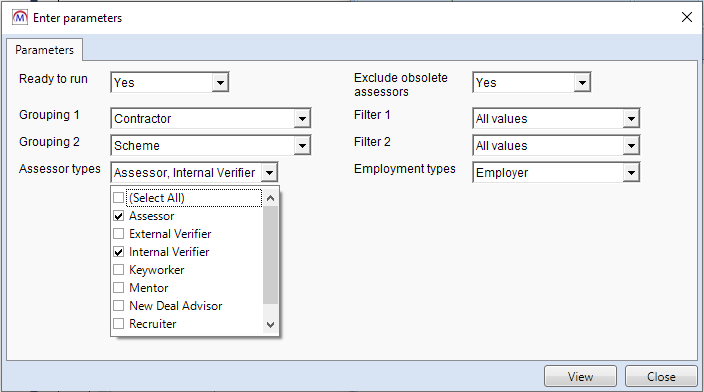
Configuration options are available to let you specify the values that are selected by default for the assessor and employment type parameters in each report. If left unchanged (or if the config options are removed), the default selections are:
- Assessor type - Assessor (short string A)
- Employment type - Employer (short string E)
These are the same types which the majority of reports previously used.
To alter these values:
- In Maytas, click the M5 button at the top left and select Options.
- Select Reports Library on the left (under the Maytas 5 header).
- Scroll down to the General section on the right.
- Ensure the checkbox is ticked for the following two config options:
- Default trainee-employer types to use in reports
- Default trainee-assessor types to use in reports
- For each config, enter the lookup short string values to be selected by default in reports, with each value comma-separated (e.g. A,B,C). The lookup fields are TRASSESSOR.ASSESSORTYPE for assessor types and TREMPLOYER.EMPLOYMENTTYPE for employment types.
- Click OK.
The configuration options only determine which types are selected by default when a report is run. If you wish to use different types when running a report, these can be selected in the report parameters.